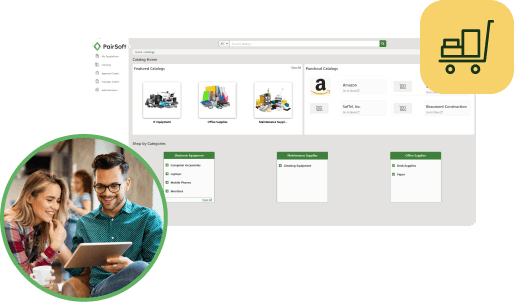
Janet Martin
Janet joined the PairSoft team upon its merger with Paramount Workplace, where she was also an integral part of the sales team for years. Janet resides in Michigan with her family.
View all posts by Janet MartinJanet Martin

ERPs have revolutionized the digital procurement landscape by providing a centralized procurement platform for data and performance management. Gone are the days of manual record-keeping and disparate spreadsheets. ERPs offer unified procurement software that enables organizations to store, access, and analyze data related to supplier management, inventory, contracts, and purchase orders in real-time. This centralized SaaS approach not only eliminates data silos, but it also enhances data accuracy and integrity, enabling procurement leaders to make informed decisions based on reliable and up-to-date spend management information.
Technology and machine learning have automated numerous procurement processes, reducing the time and effort required to complete tasks. ERPs now incorporate features such as automated purchase order generation, invoice processing, requisition tracking, and payment scheduling. These automated workflows eliminate manual errors, accelerate cycle times, and free up procurement personnel to focus on strategic activities rather than mundane administrative tasks. Additionally, automation enables organizations to enforce compliance with procurement policies and regulations, reducing the risk of non-compliance and associated penalties.
ERPs have transformed supplier relationship management by facilitating effective communication and collaboration between procurement teams and vendors. With integrated supplier portals, organizations can seamlessly interact with suppliers, share product specifications, negotiate terms, and track order statuses. This improved communication streamlines the procurement process and supply chain management, enhances transparency, and fosters stronger vendor management. Furthermore, ERPs enable organizations to evaluate supplier performance based on predefined metrics, enabling data-driven decision-making regarding supplier selection and ongoing relationships.
ERPs empower procurement professionals with advanced analytics and reporting capabilities. Through data visualization tools and customizable dashboards, organizations can gain deep insights into procurement metrics, such as spend analysis, supplier performance, and inventory levels. This data-driven approach enables proactive decision-making, identification of cost-saving opportunities, and strategic sourcing. By leveraging historical data and predictive analytics, ERPs help organizations anticipate market trends, optimize inventory levels, and negotiate better pricing with suppliers, resulting in improved profitability and competitive advantage.
Technology has significantly improved supply chain visibility, enabling procurement professionals to monitor and track goods from the point of origin to the final destination. ERPs integrate with various tracking technologies such as RFID, IoT sensors, and GPS, allowing real-time monitoring of inventory levels, shipment status, and delivery timelines. This visibility enhances inventory management, reduces stockouts, minimizes lead times, and ensures timely fulfillment of customer orders. Additionally, it enables organizations to identify bottlenecks in the supply chain, optimize logistics, and mitigate disruptions proactively, enhancing overall supply chain resilience.
The procurement industry has experienced a paradigm shift due to the integration of ERPs and new technologies. The centralization of data, process automation, improved supplier relationship management, advanced analytics, and enhanced supply chain visibility have transformed e-procurement practices. Organizations that embrace these changes stand to gain a competitive edge by improving operational efficiency, reducing costs, and making data-driven decisions. As technology continues to evolve, the procurement industry will witness further innovation and optimization, fostering collaboration, sustainability, and resilience throughout the supply chain. Embracing ERPs and technology is no longer an option, but a necessity for organizations looking to thrive in the modern procurement landscape.
Talk to an expert today to uncover how your team’s procurement stacks up against the top performers in your sector.


Many organizations start with manual receipt handling, fragmented card feeds and slow AP processes. Implement AI agents to auto-capture receipts, route approvals, enable punch-out buys and post to the ERP.
Result: faster batching, fewer errors and cost savings. “This saves us hours every month.”
Many organizations face slow, paper-heavy AP and fragmented procurement that waste time and inflate costs. AI Agents can automate approvals, PO matching and record sync to improve speed, accuracy and control. Client quote: “It freed up hours and made our process reliable.”
Operational drag and rising costs slow growth: teams waste time on manual tasks, misaligned priorities and opaque processes. AI Agents help automate routine work and coordinate actions across teams. “We’ve lost time to repeats and handoffs,” says a typical client.
Companies struggle with manual procurement, fragmented approvals, and costly integrations that slow growth and obscure spend. Our AI Agents streamline requisitions, POs, and invoice matching to cut manual work and improve visibility. “We were wasting time and missing insights,” says a client.

Many teams start with fragmented PO/AP systems, manual matching and delayed financial reporting. Deploying AI agents to automate PO checks, real-time encumbrance tracking and invoice matching reduces processing time and errors, delivering live budgets and faster closes. “Finally, we can see current balances and approve instantly.”
Many companies juggle growing invoice volumes and legacy systems. They struggle with manual processes, compliance gaps and limited headcount. Our AI Agents automate integrations, enforce rules and surface exceptions. The typical outcome: faster closes and measurable ROI. “We stopped chasing invoices.”